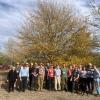Editor's Picks
Plant Focus
Poster presented at the XX International Botanical Conference, Madrid, Spain, July 21–27, 2024.
Authors:
Rubén Martín Sánchez1, Andrew L. Hipp2,3, Juan Pedro Ferrio Díaz1,4, Ana López Ballesteros1, Béatrice Chassé5, Domingo Sancho Knapik1,6, José Javier Peguero Pina1,6, Eustaquio Gil Pelegrín7
Affiliations:
1. Centro de Investigación y Tecnología Agroalimentaria de Aragón (CITA), Zaragoza, Spain
2. The Morton Arboretum, Lisle, USA
3. The Field Museum, Chicago, USA
4. Aragon Agency for Research and Development (ARAID), Zaragoza, Spain
5. Arboretum des Pouyouleix, Saint-Jory-De-Chalais, France
6. Instituto Agroalimentario de Aragón – IA2 (CITA-Universidad de Zaragoza), Zaragoza, Spain
7. Estación Experimental de Aula Dei, Consejo Superior de Investigaciones Científicas (EEAD-CSIC), Zaragoza, Spain
Abstract:
Oaks (Quercus L.) are distributed all around the northern hemisphere occupying a wide range of different climates. Phylogenetically, genus Quercus is divided into two subgenera: subgenus Quercus (New World oaks) and subgenus Cerris (Old World oaks). Both subgenera are hypothesized to have very different ancestors and evolutionary histories. New World species are supposed to have originated in the northernmost part of North America and colonized this continent as far as tropical regions in Mesoamerica and some regions in Eurasia. By contrast, Old World species are likely to have arisen under tropical regions in Southeast Asia and later colonize the Himalayas, temperate regions of Asia, and, finally, the Mediterranean Basin.
Our study searches leaf morphological convergences between oaks from different subgenera (even different sections) but adapted to a similar climate. Specifically, we analyzed the leaf adaptation to Mediterranean climates where oaks occur, the Mediterranean Basin and California. We have sampled 190 oaks species from around the world growing in The Pouyouleix Botanical Garden (France), and measured several leaf morphological traits, that have been summarized into an index created de novo for this study. We have also used occurrence data from GBIF database to extract WorldClim climatic variables from the natural distribution of each oak. We have seen that summer aridity is the best variable defining the Mediterranean climate. Finally, the phylogeny of the genus has been used to perform the phylogenetic analyses.
Mediterranean species resulted to be 38. We did not find significant differences in the rate of evolution of the morphological index but we detected significant shifts in the phylogeny when modelling summer aridity. Moreover, our analyses identified two leaf syndromes in response to the Mediterranean climate. We conclude that it exists a convergent but not exclusive morphology in one leaf syndrome, those with small rounded evergreen sclerophyllous leaves.
















